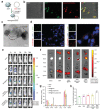Synchronous Disintegration of Ferroptosis Defense Axis via Engineered Exosome-Conjugated Magnetic Nanoparticles for Glioblastoma Therapy
- PMID: 35508804
- PMCID: PMC9189685
- DOI: 10.1002/advs.202105451
Synchronous Disintegration of Ferroptosis Defense Axis via Engineered Exosome-Conjugated Magnetic Nanoparticles for Glioblastoma Therapy
Abstract
Glioblastoma (GBM) is one of the most fatal central nervous system tumors and lacks effective or sufficient therapies. Ferroptosis is a newly discovered method of programmed cell death and opens a new direction for GBM treatment. However, poor blood-brain barrier (BBB) penetration, reduced tumor targeting ability, and potential compensatory mechanisms hinder the effectiveness of ferroptosis agents during GBM treatment. Here, a novel composite therapeutic platform combining the magnetic targeting features and drug delivery properties of magnetic nanoparticles with the BBB penetration abilities and siRNA encapsulation properties of engineered exosomes for GBM therapy is presented. This platform can be enriched in the brain under local magnetic localization and angiopep-2 peptide-modified engineered exosomes can trigger transcytosis, allowing the particles to cross the BBB and target GBM cells by recognizing the LRP-1 receptor. Synergistic ferroptosis therapy of GBM is achieved by the combined triple actions of the disintegration of dihydroorotate dehydrogenase and the glutathione peroxidase 4 ferroptosis defense axis with Fe3 O4 nanoparticle-mediated Fe2+ release. Thus, the present findings show that this system can serve as a promising platform for the treatment of glioblastoma.
Keywords: blood-brain barrier; exosomes; ferroptosis; glioblastoma; magnetic nanoparticles.
© 2022 The Authors. Advanced Science published by Wiley-VCH GmbH.
Conflict of interest statement
The authors declare no conflict of interest.
Figures






References
-
- Omuro A., DeAngelis L. M., JAMA, J. Am. Med. Assoc. 2013, 310, 1842. - PubMed
-
- Tan A. C., Ashley D. M., Lopez G. Y., Malinzak M., Friedman H. S., Khasraw M., CA Cancer J. Clin. 2020, 70, 299. - PubMed
-
- Le Rhun E., Preusser M., Roth P., Reardon D. A., van den Bent M., Wen P., Reifenberger G., Weller M., Cancer Treat. Rev. 2019, 80, 101896. - PubMed
-
- Stupp R., Taillibert S., Kanner A., Read W., Steinberg D., Lhermitte B., Toms S., Idbaih A., Ahluwalia M. S., Fink K., Di Meco F., Lieberman F., Zhu J. J., Stragliotto G., Tran D., Brem S., Hottinger A., Kirson E. D., Lavy‐Shahaf G., Weinberg U., Kim C. Y., Paek S. H., Nicholas G., Bruna J., Hirte H., Weller M., Palti Y., Hegi M. E., Ram Z., JAMA, J. Am. Med. Assoc. 2017, 318, 2306. - PMC - PubMed
Publication types
MeSH terms
Substances
Grants and funding
- 81874083/National Natural Science Foundation of China
- 82072776/National Natural Science Foundation of China
- 82072775/National Natural Science Foundation of China
- 81702468/National Natural Science Foundation of China
- 81802966/National Natural Science Foundation of China
- 81902540/National Natural Science Foundation of China
- ZR2019BH057/Natural Science Foundation of Shandong Province of China
- ZR2020QH174/Natural Science Foundation of Shandong Province of China
- 2020SDUCRCA011/Key clinical Research project of Clinical Research Center of Shandong University
- tspd20210322/Taishan Pandeng Scholar Program of Shandong Province
- 2021CXGC010603/Major Scientific and Technological Innovation Project of Shandong Province
LinkOut - more resources
Full Text Sources
Medical
Research Materials
Miscellaneous
